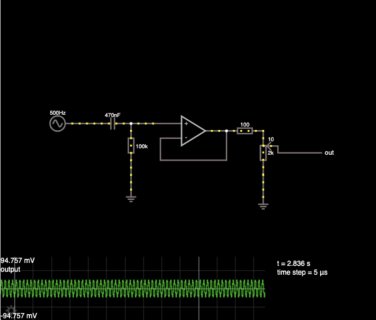jidagraphy
Active member
Short version :
Im gonna drive an audio out from the onboard DAC. I'm going to use an opamp to drive my signal to a 'commercial standard' of synth line levels. How much max voltage/current/loudness should my final signal be?
or what circuitry should I be using from my DAC pin to my 3.5mm audio jack?
Kinda longer version:
Situation as above, I'm gonna be driving my signal through an MCP6002 opamp from my teensy's onboard DAC, with internal reference of 0v-1.2v. And of course, i'll have a capacitor in series before the opamp that will remove the 0.6v dc offset. (Maybe a safety 1k resistor at the end? not sure yet)
Now I'm a little baffled as to how I should set my final signal. I want my synth to be at a similar level as my other commercial synths (Korg Volcas, TE OP-1 and PO series, etc) but I'm worried I might mess up my mixer or audio interface with wrong voltage/current/impedance setting. I'm worried that I might maybe over amplify/ send too much current and whatnot.
Instead of trying to ask what I dont understand, I'll list some use cases for my synth.
- I would want to be able to listen on any commercial earphones. Apple Earpods, for example.
- I could connect my synth to my mixer (Korg Volca Mix), alongside my other synths (Korg Volca Keys, Modular, FM, Teenage Engineering OP-1, PO series etc). It says on their specification that the mixer expects a (maximum of, i think?) 0dBu signal from its inputs?
- Or maybe I could drive my synth through my audio interface Focusrite Clarett 8Pre's input?
- I dont know if i would ever do this, but for my curiosity's sake, what about if I drive the already-amplified signal to a guitar amp? or any other amplifiers? I would guess this wouldn't really make any difference as a lot of synth already amplifies out going signal anyway, right?
Yeah... coding is rarely my problem but electronics always gets me
So my question - what should I do, circuit-wise, between my teensy's DAC pin and the outputting 3.5mm audio jack?
Thank you guys always.
Jin
Im gonna drive an audio out from the onboard DAC. I'm going to use an opamp to drive my signal to a 'commercial standard' of synth line levels. How much max voltage/current/loudness should my final signal be?
or what circuitry should I be using from my DAC pin to my 3.5mm audio jack?
Kinda longer version:
Situation as above, I'm gonna be driving my signal through an MCP6002 opamp from my teensy's onboard DAC, with internal reference of 0v-1.2v. And of course, i'll have a capacitor in series before the opamp that will remove the 0.6v dc offset. (Maybe a safety 1k resistor at the end? not sure yet)
Now I'm a little baffled as to how I should set my final signal. I want my synth to be at a similar level as my other commercial synths (Korg Volcas, TE OP-1 and PO series, etc) but I'm worried I might mess up my mixer or audio interface with wrong voltage/current/impedance setting. I'm worried that I might maybe over amplify/ send too much current and whatnot.
Instead of trying to ask what I dont understand, I'll list some use cases for my synth.
- I would want to be able to listen on any commercial earphones. Apple Earpods, for example.
- I could connect my synth to my mixer (Korg Volca Mix), alongside my other synths (Korg Volca Keys, Modular, FM, Teenage Engineering OP-1, PO series etc). It says on their specification that the mixer expects a (maximum of, i think?) 0dBu signal from its inputs?
- Or maybe I could drive my synth through my audio interface Focusrite Clarett 8Pre's input?
- I dont know if i would ever do this, but for my curiosity's sake, what about if I drive the already-amplified signal to a guitar amp? or any other amplifiers? I would guess this wouldn't really make any difference as a lot of synth already amplifies out going signal anyway, right?
Yeah... coding is rarely my problem but electronics always gets me
So my question - what should I do, circuit-wise, between my teensy's DAC pin and the outputting 3.5mm audio jack?
Thank you guys always.
Jin


